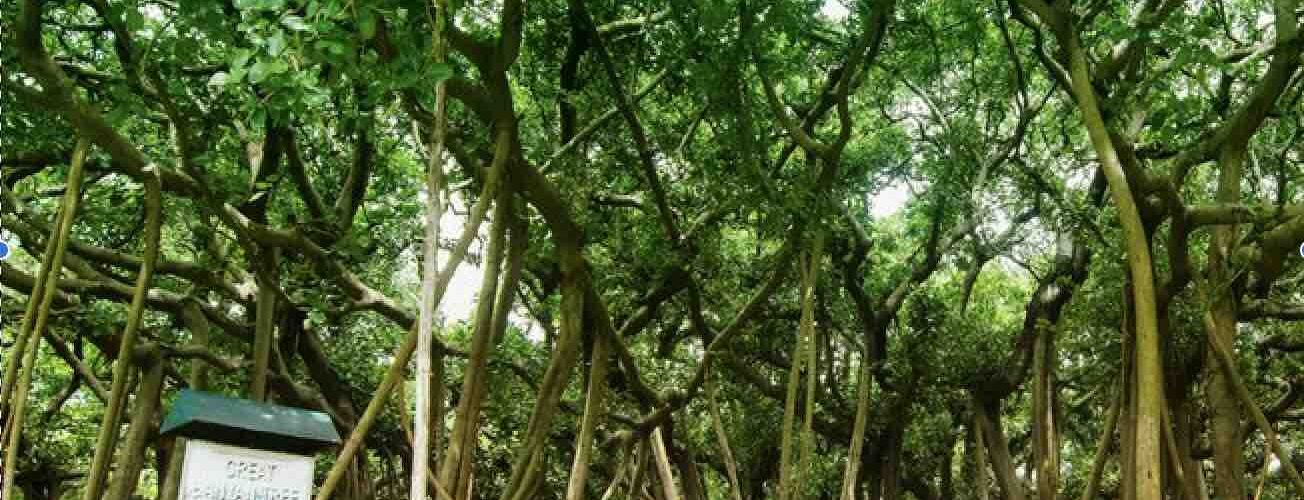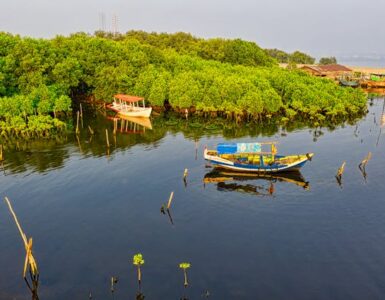“A living testament to time and resilience.”
The banyan tree is often the subject of such proverbs, yet I confess I never truly grasped their meaning. Even after twenty-four years in Kolkata, the usual praises held little resonance for me.
However, a single encounter with this extraordinary specimen transformed my entire understanding, revealing the true majesty of this botanical wonder –
- The number of aerial roots touching the ground is over 2,880.
- It covers an area of 1.5 hectares.
- The area occupied by the tree is more than 14,428 square feet.
- The circumference of the canopy is 450 m and the highest branch rises to over 24.5 m.
From a tiny seed…

Banyan trees, among the oldest living species, have long been the subjects of captivating and unsettling tales. In India, these majestic trees hold a unique significance, revered not only for their religious importance but also as symbols of eternal life, thanks to their ever-expanding canopies.
Estimated to be over 250 years old, the Great Banyan dominates the landscape of the Acharya Jagadish Chandra Bose Indian Botanic Garden in Shibpur, Howrah, Kolkata, sprawling across an astounding 4.67 acres.
While banyan trees are known for their expansive growth through aerial roots, the Great Banyan tree of Kolkata is particularly remarkable.
Today, despite the presence of hundreds of exotic plant species from around the globe, the botanical garden is essentially defined by this single, magnificent tree.
The garden, renamed in 2009 to honour the natural scientist Jagadish Chandra Bose, was originally established in 1787 by Colonel Robert Kyd of the East India Company. His initial aim was to cultivate commercially valuable plants, including spices, tea, and teak.
Little could he have imagined that centuries later, a single strangler fig would evolve into the world’s largest banyan tree.
Weathering challenges
Although precise planting records are unavailable, 19th-century travelogues mention its existence on a date palm. The banyan tree resembles a miniature forest, its horizontal branches sustained and nourished by these pillar-like roots, carefully guided and trained from initial growth through bamboo channels.
Covering 18,918 sq. m., with a crown circumference of 486 m. and the highest branch reaching 24.5 m., the banyan tree stands as a testament to time and resilience.
The Great Banyan tree of Kolkata has endured numerous threats, including a lightning strike in 1925 that led to disease and the removal of parts of the tree, effectively creating a clonal colony rather than a single, unified organism.
It also withstood two severe cyclones in 1864 and 1867, surviving with only broken branches. Later, in 1925, its 51-foot main trunk, heavily infected with fungus, was removed to save the remaining tree. However, its numerous aerial roots helped the tree to continue to expand.
About the place
Thousands of tourists visit the Acharya Jagadish Chandra Bose Indian Botanic Garden in Howrah annually to witness this world-renowned banyan tree. It is also amazing to observe that the Botanical Garden is a wonder in itself.
The Garden houses over 12,000 plant specimens. Initially, the garden played a crucial role in establishing tea cultivation in India, introducing the plant from China and supplying it for cultivation in the Himalayan foothills of West Bengal and Assam.
In 1793, under botanist William Roxburgh’s superintendence, a herbarium was developed, housing plant specimens collected throughout India.
Today, the Howrah Botanical Gardens showcase a diverse collection of rare plant species within its numerous glasshouses, greenhouses, and conservatories. The garden is also renowned for its collections of orchids, palms, cacti, aquatic plants, bougainvillaea, jasmine, and lilies.
Travel information
If you wish to visit the Great Banyan tree of Kolkata, it is safe to say that the city enjoys a generally moderate climate. The months from October to January offer pleasant weather with mild temperatures. The peak of summer, during April and May, is characterized by high humidity, making it a less ideal time to visit.
Located 12.5 kilometres from central Kolkata, the majestic tree is easily accessible via various modes of transport.
Local buses, trains, the metro, and ferry services provide convenient connections throughout the city. Howrah Railway Station, the closest rail hub, is 7.8 kilometres away, while Kolkata’s airport is 29.4 kilometres from the tree. Taxis and auto-rickshaws are readily available for comfortable travel.
…grew a mighty tree
More than just a tree, it is a living monument, a symbol of resilience, and a testament to nature’s enduring power. The Great Banyan tree of Kolkata is where history, botany, and human experience converge, creating an unforgettable encounter.
Recognized by the Guinness Book of World Records for its expansive canopy, this “walking” or “immortal” tree, as it is known locally, is one of the world’s largest living entities.
It is a precious natural heritage, a legacy demanding preservation for future generations. Therefore, various efforts are being undertaken to protect the trees and the garden from disease, pollution, and human encroachment.
The article is written by





Add comment